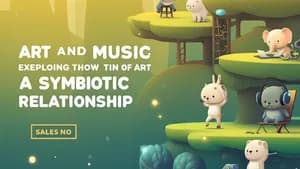Visualizing Music: How Art Captures Sound
From ancient cave paintings to modern music videos, art and music have long been intertwined. This article explores how visual art can capture the essence of musical sounds, analyzing techniques used by artists to translate musical emotions and rhythms into tangible forms.
The Language of Shapes and Colors
Think about your favorite song. Do you associate it with certain colors or shapes? Maybe you imagine a bright, swirling scene for a lively pop song, or a dark, angular landscape for a heavy metal track. Artists use visual elements to evoke the same emotions and sensations you feel when listening to music.
Take, for example, the iconic album cover for Pink Floyd's Dark Side of the Moon. The prism, splitting white light into its spectrum of colors, beautifully reflects the album's exploration of the darker aspects of human nature. The use of strong geometric shapes further emphasizes the album's themes of order and chaos.
You can apply this to your own art! When you're creating a visual piece inspired by music, consider how colors and shapes can embody the music's mood and energy. If you're working with a lively, upbeat piece, try using vibrant colors and dynamic shapes. For a more somber piece, you might opt for subdued colors and simple, geometric forms.
Capturing Rhythm and Motion
Music is full of movement, from the steady beat of a drum to the soaring melody of a violin. Artists can translate this movement into their artwork through different techniques:
- Line: Think of a single, continuous line as a musical phrase. The curves and angles of the line can convey the tempo and rhythm of the music. Imagine a straight, horizontal line representing a slow, steady beat, while a zig-zagging line reflects a faster, more chaotic tempo.
- Composition: The arrangement of elements within your artwork can also represent the movement of music. For instance, you might use a symmetrical composition for a piece with a steady, predictable rhythm, while an asymmetrical composition might represent a more unpredictable or improvisational piece.
- Texture: You can use texture to create a visual representation of sound. For example, a smooth, flowing texture might represent a gentle, lyrical melody, while a rough, textured surface might represent a heavier, more intense sound.
Think about your favorite musical artists. How do their music videos translate the energy and rhythm of their music visually? How are the camera angles, editing techniques, and visual elements used to evoke specific emotions?
Music as Inspiration: A Deeper Connection
Music can not only inspire visual art, but it can also deepen our understanding of the world around us. By connecting the world of sound to the visual, we can see things in a new light. Think about how a calming melody might make you see a scene in a more peaceful way. Or how a powerful piece of music might make you see a scene with more intensity.
Here's a suggestion: try listening to a piece of music while drawing or painting. You can use your favorite tunes or explore something new. Focus on how the music makes you feel and translate those emotions into your artwork. You can even create a series of drawings or paintings inspired by different musical genres.
Beyond the Canvas: Visualizing Music in Everyday Life
The relationship between music and visual art isn't confined to galleries or studios. It's all around us! Think about the way music is used in films, television shows, and even commercials. Visual elements are strategically used to enhance the emotional impact of the music. You can find visual elements in everyday life that connect with music.
Take, for example, a bustling city street. The sounds of traffic, conversations, and music blend together, creating a dynamic symphony. You can capture this in your own visual art. Imagine drawing a busy street scene, using bold colors and energetic lines to represent the cacophony of sounds. Or perhaps you see a lone tree standing tall in a field, and you visualize a tranquil melody accompanying the scene. This is your chance to practice seeing music in everyday life and translating it into your own creative expressions.
Conclusion
As you explore the world around you, take a moment to listen to the sounds and connect them with your visual perception. You'll discover a deeper understanding of the world and find new ways to express your creativity through art. You might be surprised at the depth and beauty of the connection between music and art. Remember, you don't need to be a professional artist to appreciate and explore this fascinating relationship. Just embrace your creativity, open your senses, and let the music guide your artistic journey. You never know what you might discover!

